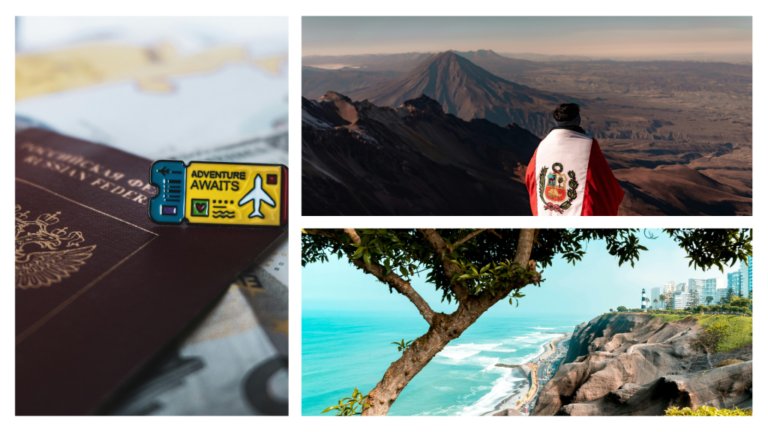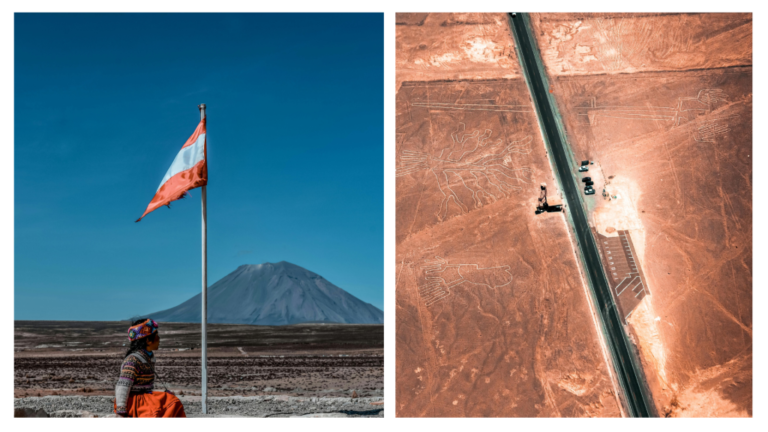Peru Digital Nomad Visa 2025: Application Process and Tips
Discover the latest news about the digital nomad visa in Peru and the most recommended options for travelling to this South American destination.
In an increasingly globalised and digitised world, the concept of digital nomads has become a reality in Latin America, and Peru, a country where tourism is one of the main sources of income, is seeking to position itself as a fixed destination for digital nomads. According to a survey by the job portal Bumeran, almost 100% of respondents said they would like to work remotely. This being the case, Peru has taken a significant step by approving a decree establishing a visa for digital nomads, pending it coming into effect.
So if you are dreaming of working while enjoying the sights and heights of Cusco or the warm beaches of Mancora, at Holafly we tell you all about the digital nomad visa for Peru and all the most viable options to settle legally in Peru for an extended period of time while working from your laptop or mobile. We also invite you to stay always connected in Peru with the Holafly data eSIM that gives you fast and reliable internet wherever you go.

Updates on the digital nomad visa in Peru
Peru’s digital nomad visa was approved in November 2023 as part of an effort to attract foreign talent working remotely and foster the local economy through tourism as well as cultural exchange, according to the National Superintendence of Migration. However, as of 2024 this visa has not yet become effective.
The Peruvian government has signalled its intention to implement this visa once a resolution is approved that clearly details the changes to the Migration Law and the corresponding steps for this procedure in the country.
According to the official government website, the digital nomad visa for Peru will be aimed at professionals, remote workers and travellers who wish to stay in the territory for a longer period than the 90 days established in the current tourist visa, so that they have the opportunity to enjoy the tourist, cultural and gastronomic offerings that this South American country has to offer.
If you are interested in finding out about the countries that already have a visa available for digital nomads and mark them as next destinations , we invite you to read this article.
Specific features
- Type of activity: it allows digital nomads to work for foreign companies or as freelancers.
- Duration: the visa will allow a stay of 365 days, with an option to renew.
- Entry requirements and documentation: the procedure to be followed and the requirements are still under development, as part of the amendments to Legislative Decree 1582 of the Peruvian Migration Law.
This decree signifies a further step towards the globalisation of remote working and the improvement of legal frameworks for access for professionals who wish to lead the digital nomad lifestyle and make the world their office.
Types of visas available in Peru for digital nomads

Despite the arrival of the digital nomad visa for Peru, it is not yet in effect, so it is necessary to evaluate the current options that may be useful for digital nomads. We will analyse each of these visas in detail, highlighting their characteristics, requirements, advantages and disadvantages.
1. Tourist visa
Although their primary purpose is recreation, many digital nomads opt for this visa to enjoy Peru’s rich culture and landscapes while working remotely. Some countries in Latin America and Europe do not require a visa to enter Peru as a tourist, so we recommend you check the list on the official website of the Peruvian government, and make sure if you need a visa.
Main features
- Purpose: The tourist visa is designed exclusively for recreational purposes. It does not allow immigration activities, permanent residence or paid employment.
- Duration: This visa allows a maximum stay of 90 days, extendable up to 183 days.
- Assessment: Each application is assessed individually by the consul, which means that approval is not guaranteed and additional documentation may be required during the process.
- Refusal requirements: If the application is rejected, the applicant must wait six months before submitting a new application. Moreover, the refusal is final and not subject to appeal.
Important: If you are a frequent traveler and want to stay connected without worrying about expensive roaming or looking for a new SIM at every destination, Holafly’s subscription plans are for you. With a single eSIM, enjoy internet in more than 170 countries for a fixed price and no surprises on your bill. Travel without limits and connect easily and securely! 🚀🌍

Requirements
To apply for a tourist visa, digital nomads must present various documents at Peruvian consular offices, which may include:
- Valid passport with a minimum validity.
- Recent photographs.
- Completed application form.
- Proof of accommodation in Peru.
- Travel itinerary.
- Proof of sufficient funds to cover the stay.
| Advantages | Disadvantages |
| –Access to a rich cultural environment: Peru offers a great cultural, touristic and culinary diversity, which makes it an attractive destination for digital nomads. – Ease of application: For citizens of many Latin American and European countries, no visa is required, which simplifies the process. | –Employment limitations: No economic activity is allowed in the territory under this visa. – Application process: The need for individual assessment may lengthen the waiting time. – Strict requirements: The possibility of additional documentation requirements may complicate travel planning |
2. Temporary worker visa in Peru
This permit allows foreigners to carry out work activities, both in the public and private sector, provided they meet certain requirements and conditions. Below, we explain its characteristics, requirements and also help you to analyse the advantages and disadvantages of this migratory status.
Main features
- Work permit: The migratory status of temporary worker allows you to work in Peru, either as an employee (dependent) or as a service provider (independent).
- Recruitment requirements: Have an employment contract or an administrative relationship that demonstrates the intention to work in the country.
- Application from abroad: To apply for this migratory status, the applicant must be outside Peru
- Employer verification: The hiring entity must be active and registered with the National Superintendence of Customs and Tax Administration (Sunat), ensuring that the employment is legitimate and complies with tax regulations.
Requirements
In order to obtain temporary worker status, several documents must be submitted, including:
- Completed and signed form with receipt number and date of payment for the processing fee.
- Copy of valid passport.
- Sworn statement indicating the absence of criminal, judicial and police records.
- Copy of the current employment contract, with a maximum of 30 days from its issuance, approved by the corresponding labour authority.
- Affidavit of the legal representative of the company, specifying details of the company and its capacity to contract.
- International Exchange Card issued by Interpol, valid for no more than 6 months.
| Advantages | Disadvantages |
| – Employment opportunity: Allows digital nomads to obtain an employment contract and generate income while exploring the country. – Access to employment benefits: By working formally, employees can access employment benefits and social security in Peru. – International experience: Working in Peru provides the opportunity to gain experience in a multicultural environment. | – Limits of the application: The need to be outside the country to apply can complicate the process for those already in Peru. – Administrative requirements: The collection of documents and the need for a valid contract can be cumbersome, especially if the contract is signed abroad. – Employer dependency: Migration status is subject to the working relationship with the employer, which can limit the flexibility that many digital nomads seek. |

3. Peru Business Visa
The business visa is the option for professionals seeking to establish business relations or enter into contracts in Peru. This permit is required for foreigners wishing to conduct business activities in the country, and although some citizens can enter without restrictions thanks to bilateral agreements, a visa is mandatory to enter into any contract.
Main features
- Commercial purpose: This visa is specifically intended for commercial activities, including negotiating contracts, attending meetings and business promotion activities.
- Duration: The maximum length of stay is 90 days, either as a continuous visit or consecutive visits, for a period of six months.
- Individual assessment: The visa application does not guarantee the granting of a visa; each case is assessed individually by the Peruvian consul.
- Additional requirements: During the processing of the application, additional documents may be requested, which may complicate and extend the processing time.
Requirements
To apply for a business visa, digital nomads must submit several documents, including:
- Duly completed application form.
- Copy of valid passport.
- Documentation proving the business relationship or contract to be established in Peru.
- Invitation letter from the Peruvian company with which you plan to do business.
- Proof of sufficient funds for the stay in Peru.
| Advantages | Disadvantages |
| – Networking opportunity: The business visa allows digital nomads to establish valuable connections and explore opportunities for collaboration in a dynamic business environment. – Access to local markets: Allows participation in the Peruvian market, facilitating the exploration of new commercial opportunities and business expansion. – Flexibility for activities: Unlike other visas that limit work activities, the business visa allows for a wider range of business interactions. | – Complicated application process: Submitting multiple documents and complying with specific requirements may require additional time in the application process. – Uncertainty of approval: Individual assessment and the possibility of requesting additional documents may create uncertainty about the outcome of the application. – Limitations of stay: Restrictions on the length of stay in the country may affect long-term business planning. |
Which Peruvian visa is recommended for digital nomads?
For most digital nomads looking to work and enjoy Peruvian culture, the tourist visa is currently the most convenient option, pending the already announced digital nomad visa for Peru, and these are the reasons why:
- Accessibility: The tourist visa is easy to obtain and allows for quick entry into the country.
- Flexibility of work: It allows you to work remotely for foreign companies without administrative complications.
- Adequate duration: With the possibility of extending the stay, it offers enough time to enjoy Peru.

How do I apply for a tourist visa as a digital nomad in Peru?
1. Prepare your documents:
- Make sure you have a valid passport with at least six months validity.
- Prepare a return ticket.
- Have evidence of sufficient funds (e.g. bank statements).
2. Submit your application: The application can be submitted at Peruvian embassies and consulates in your home country.
3. Wait for approval:
Once you meet the basic requirements, you will be contacted by telephone and if necessary an interview will be scheduled.
Costs of visas and temporary permits in Peru
The costs associated with visas can vary considerably depending on the type and country of origin. In the case of a tourist visa, there are generally no additional costs, as no formal application process is required. However, if you decide to opt for a work or business visa, costs may include:
- Application fees: They vary according to the type of visa, but usually range from $50 to $185.
- Legal fees: If you opt for legal advice, this can increase costs significantly.
- Additional documentation: Some documents may require translation or legalisation.
Where can I find out about visas for Peru?
For up-to-date and accurate information on the digital nomad visa for Peru and other immigration procedures, we recommend:
- National Superintendency of Migration: The official website provides information on updated requirements and procedures.
- Embassies and consulates: Peruvian representations in your country provide specific and personalised information.
- Digital nomad groups and forums: Participating in online communities can be useful to get experiences and advice from other nomads already in Peru.

Where can I get tailored advice on the digital nomad visa recommendations in Peru?
Legal advice can be crucial in navigating the visa process. Here are some options for personalised help:
1. Newland Chase
This is a consulting firm specialising in immigration and visa management services, with a presence in several countries, including Peru. They offer personalised advice to individuals and companies on migration processes, complying with local regulations.
Services offered
- Visa counselling: They help manage different types of visas, including work, business and residence visas.
- Processing: They are responsible for collecting and submitting the necessary documentation to obtain visas and work permits.
- Legal compliance: Advice on current Peruvian immigration legislation and compliance with the necessary requirements.
2. Migration Consulting
This is another company dedicated to offering immigration consultancy and visa management services in Peru. Its focus is on helping foreign nationals navigate the migration process effectively.
Services offered
- Visa counselling: They provide guidance on different types of visas, including work, business and tourist visas.
- Migratory procedures: They are in charge of the management and presentation of the documentation required to obtain visas and permits.
- Legal advice: They offer legal services related to migration, ensuring compliance with Peruvian regulations.
Frequently asked questions about the digital nomad visa in Peru
The digital nomad visa is designed for professionals who work remotely and wish to reside in Peru for an extended period of time. Unlike the tourist visa, which limits work activity and has a shorter duration, the digital nomad visa allows you to work legally from the country.
The digital nomad visa allows a stay of up to 365 days, with the possibility of renewal, providing greater flexibility for those wishing to stay longer.
It is not necessary to have a local employment contract. Applicants can work for foreign companies or as freelancers while in Peru.
While waiting for the implementation of the digital nomad visa, you can opt for a tourist visa or temporary worker status, depending on your needs and plans in the country.
The tourist visa can be extended for a maximum of 183 days. To apply for the extension, you must submit an application to the National Superintendency of Migration with the required documentation, such as evidence of funds and reasons for the extension.
Although the digital nomad visa is not yet available, costs are expected to be similar to other visas, ranging from USD 50 to USD 185, plus possible fees for legal advice and additional documentation.
Although the specific requirements have not yet been fully defined, it is anticipated that documents such as a valid passport, proof of remote or freelance employment, evidence of sufficient funds and a formal application filed with the immigration authorities will be required.





 Language
Language 


















 No results found
No results found







